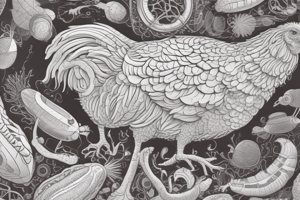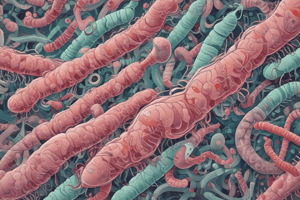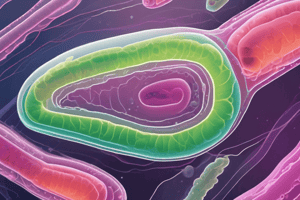Podcast
Questions and Answers
What indicates a positive result for indole production after adding Kovac’s reagent?
What indicates a positive result for indole production after adding Kovac’s reagent?
- Green slant formation
- No ring formation
- Red ring formation (correct)
- Yellow ring formation
Which organisms produce a positive urease test?
Which organisms produce a positive urease test?
- Escherichia coli
- Salmonella enterica
- Proteus vulgaris (correct)
- Klebsiella pneumoniae
What result is indicative of no green slant formation in the FeCl3 test?
What result is indicative of no green slant formation in the FeCl3 test?
- Negative result indicated by yellow color (correct)
- Presence of hydrogen sulfide production
- Positive result for Proteus species
- Positive result for Morganella species
How much inoculum is required for a urease test?
How much inoculum is required for a urease test?
What does the addition of 10% FeCl3 help to identify in the test results?
What does the addition of 10% FeCl3 help to identify in the test results?
What is the primary virulence factor associated with E. coli O157:NM?
What is the primary virulence factor associated with E. coli O157:NM?
Which of the following outbreaks is NOT associated with E. coli O157:NM?
Which of the following outbreaks is NOT associated with E. coli O157:NM?
What reaction does E. coli O157:NM exhibit in Triple Sugar Iron (TSI) testing?
What reaction does E. coli O157:NM exhibit in Triple Sugar Iron (TSI) testing?
Which toxin is produced by E. coli O157:NM that affects vascular endothelial cells?
Which toxin is produced by E. coli O157:NM that affects vascular endothelial cells?
Which characteristic is true about E. coli O157:NM regarding lactose fermentation?
Which characteristic is true about E. coli O157:NM regarding lactose fermentation?
What is the mode of transmission for pathogenic E. coli?
What is the mode of transmission for pathogenic E. coli?
What colony characteristic is associated with E. coli on MacConkey agar?
What colony characteristic is associated with E. coli on MacConkey agar?
What does a yellow slant and yellow butt indicate in a TSI test for E. coli?
What does a yellow slant and yellow butt indicate in a TSI test for E. coli?
What type of toxins are produced by Enterotoxigenic E. coli (ETEC)?
What type of toxins are produced by Enterotoxigenic E. coli (ETEC)?
What is the significance of indole production in E. coli testing?
What is the significance of indole production in E. coli testing?
In which agar medium might E. coli show β-hemolytic activity?
In which agar medium might E. coli show β-hemolytic activity?
What does aerogenic mean in the context of a TSI test?
What does aerogenic mean in the context of a TSI test?
What effect do enterotoxins from ETEC have on the intestines?
What effect do enterotoxins from ETEC have on the intestines?
Which of the following describes the motility of marcescens?
Which of the following describes the motility of marcescens?
What characteristic distinguishes coliforms from other Gram-negative rods?
What characteristic distinguishes coliforms from other Gram-negative rods?
Which statement about the urease test results of Proteus is accurate?
Which statement about the urease test results of Proteus is accurate?
What is a common description of the colonies formed by the genus Proteus?
What is a common description of the colonies formed by the genus Proteus?
In the IMVIC reaction, what result indicates the detection of tryptophanase?
In the IMVIC reaction, what result indicates the detection of tryptophanase?
Which of the following properly describes ONPG for marcescens?
Which of the following properly describes ONPG for marcescens?
How do marcescens strains generally perform on lactose fermentation?
How do marcescens strains generally perform on lactose fermentation?
Which of the following genera is associated with urinary tract infections next to E. coli?
Which of the following genera is associated with urinary tract infections next to E. coli?
What is the primary purpose of using differential moderately selective media in stool cultures?
What is the primary purpose of using differential moderately selective media in stool cultures?
Which media is specifically used for isolating S. typhi and Shigella species?
Which media is specifically used for isolating S. typhi and Shigella species?
What does the presence of black centers on colonies in Salmonella Shigella Agar (SSA) indicate?
What does the presence of black centers on colonies in Salmonella Shigella Agar (SSA) indicate?
Which media is NOT used to isolate coliforms in stool cultures?
Which media is NOT used to isolate coliforms in stool cultures?
In which type of media would you isolate Salmonella species specifically?
In which type of media would you isolate Salmonella species specifically?
What is the role of pH indicators in differential moderately selective media?
What is the role of pH indicators in differential moderately selective media?
What characteristic of Shigella spp. colonies is typically observed on Salmonella Shigella Agar?
What characteristic of Shigella spp. colonies is typically observed on Salmonella Shigella Agar?
Which of the following best describes the purpose of enrichment media in stool culture?
Which of the following best describes the purpose of enrichment media in stool culture?
Study Notes
Escherichia coli (E. coli)
- E. coli is a facultative anaerobe, gram-negative rod that is part of the normal flora of the human gut.
- It is a lactose fermenter, with greenish, metallic sheen colonies on EMB agar.
- It can ferment lactose producing yellow slant and yellow butt, and gas, on TSI agar.
- Indole positive: Tryptone broth with a red ring when Kovac’s reagent is added.
Pathogenic Strains of E. coli
- There are five pathogenic strains of E. coli: enterotoxigenic (ETEC), enteroinvasive (EIEC), enterohemorrhagic (EHEC), enteropathogenic (EPEC), and enteroaggregative (EAEC).
Enterotoxigenic E. coli (ETEC)
- ETEC produces two enterotoxins: heat-labile toxin (LT) and heat-stable toxin (ST).
- These toxins cause watery diarrhea by inducing water and electrolytes into the lumen of the small intestines.
Laboratory Diagnosis of Pathogenic E. coli
- Identification of pathogenic E. coli strains relies on culture methods, biochemical tests, and molecular detection.
Enrichment Media & Techniques
- Specialized media such as Salmonella Shigella Agar (SSA), Selenite F Broth, Tetrathionate Broth, and Gram-negative Broth (GN broth) are utilized to isolate enteric pathogens from stool samples.
- These media inhibit the growth of coliforms while promoting the growth of enteropathogens.
Salmonella and Shigella Isolation
- Stool or rectal swabs are inoculated into enrichment media like Selenite F Broth or Tetrathionate Broth followed by subculturing on selective media like SSA.
- Salmonella is isolated from Tetrathionate Broth, while Shigella is isolated from Selenite F Broth.
Differentiation of E. coli Strains
- Identifying the specific strain of pathogenic E. coli is important for appropriate treatment and infection control.
- The differentiation of the strains can be achieved using serological tests and molecular methods.
Coli O157: H7
- This is a non-motile strain that synthesizes the K1 antigen and Verotoxin or Shiga-like toxin.
- Verotoxin damages vascular endothelial cells and can cause hemorrhagic colitis.
- This strain has been linked to foodborne outbreaks, particularly in meat products like hamburgers.
Other Important Microorganisms
- Other notable Gram-negative rods that may be encountered in the laboratory include Proteus, Providencia, and Morganella.
- They are non-lactose fermenters and rapid urease producers. These organisms are commonly associated with urinary tract infections.
Proteus
- Proteus is a motile bacterium with a distinctive foul odor and "chocolate cake" or "burnt chocolate" colonies on agar plates.
- It produces the enzyme tryptophanase and can be identified via the IMVIC reaction (Indole, Methyl Red, Voges-Proskauer, Citrate).
- It is commonly found in the gut and is associated with urinary tract infections.
Studying That Suits You
Use AI to generate personalized quizzes and flashcards to suit your learning preferences.
Related Documents
Description
This quiz covers essential information about Escherichia coli, including its characteristics, pathogenic strains, and the laboratory diagnosis methods used for identification. Test your knowledge on the role of E. coli in the human gut and the implications of its pathogenic variants.




